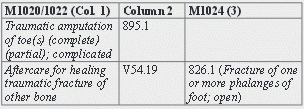Home Health Coding and OASIS Expert
You Be the Coder:
Don't Get Tripped Up By Toe Amputation Coding
Published on Wed Aug 20, 2014
Question: Our patient ran over his right foot with a lawn mower. He had an open fracture of the big toe and amputated toes two-four. The physician performed an incision and drainage, wound vac, and lavage. The physician notes also say that the amputated toes were surgically amputated to shorten the fragmented bone and gross contamination down to the metatarsophalangeal joint region. The wound was packed and left open and the patient has orders to return in 48 hours for a second wash out. How should we code for this patient? And is this still a trauma wound or do the further toe amputations change it to a surgical wound?
Delaware Subscriber
Answer: This patient’s wounds remain traumatic amputation, despite the surgical treatment, says Lisa Selman-Holman, JD, BSN, RN, HCS-D, COS-C, HCS-O, consultant and principal of Selman-Holman & Associates and CoDR — Coding Done Right in Denton, Texas. You may be tempted to code for them as surgical amputations, but they are traumatic amputations.
Your patient’s amputated toes were contaminated with foreign bodies (gross contaminants) for which the patient will receive a second wash out, making this a complicated wound. It’s not appropriate to code for a complicated wound with a V code, so you’ll need to report a complicated wound code for these injuries.
But this patient also has an open fracture of the distal end of the big toe. You can’t report a trauma fracture code in home health, complicated or not, so you’ll have to list an aftercare code for this injury paired with the fracture code in M1024. There is no way to code the wound caused by the open fracture for home care in ICD-9.
To code for this patient in ICD-9, list the following codes:

M1021a: S98.221D (Partial traumatic amputation of two or more right lesser toes; subsequent encounter);
M1023b: S92.421D (Displaced fracture of distal phalanx of right great toe; subsequent encounter for fracture with routine healing).
ICD-10 offers codes for complete and partial traumatic amputations. List the complete amputation code when the medical record doesn’t indicate whether the amputation was complete or partial. The physician indicates that the patient’s toes were further amputated surgically to the metatarsophalangeal joint region, so the traumatic amputations in your patient’s case would have been partial.
In ICD-10, fractures may be classified as open or closed or as displaced or nondisplaced. When a fracture isn’t specified as open or closed, default to the closed code. When the fracture isn’t specified as non-displaced or displaced, default to displaced.
This fracture is open, but while the ICD-10 code set provides the specificity of open fracture codes for other fractures, that level of detail isn’t available for subsequent care of this type of fracture.
Because of the documentation of gross contamination of the amputation wounds, you should query the physician regarding any delayed healing status for this open fracture. If delayed healing is documented, you can report S92.421G (Displaced fracture of distal phalanx of right great toe; subsequent encounter for fracture with delayed healing).
Take note: In ICD-10, delayed healing is the only type of complication code available for trauma wounds.
Other Articles in this issue of
Home Health Coding and OASIS Expert
- Conquering Case Mix:
Say Goodbye to Case Mix Points for Diabetes in 2015
Proposed rule slashes 200 diagnosis codes from the case mix list. CMS proposes making major [...] - PPS:
Take 3 Steps to Guard Against Outcome Dings in 2015
Don’t wait to make changes that will benefit your agency under P4P. The details of [...] - Medical Review:
Meet the New #1 Denial Reason: Lack Of OASIS Support
Diagnosis code sequence matters when it comes to accurate reimbursement. Does your documentation support your [...] - Composition of HIPPS Codes for HH PPS
What goes into a HIPPS code? Review this helpful table from the Centers for Medicare [...] - Take a Closer Look at What Goes into HIPPS Codes
Recent Palmetto GBA medical reviews target HIPPS codes 5BHK* and 5AGK*. The first character in [...] - You Be the Coder:
Don't Get Tripped Up By Toe Amputation Coding
Question: Our patient ran over his right foot with a lawn mower. He had an open [...]
View All

